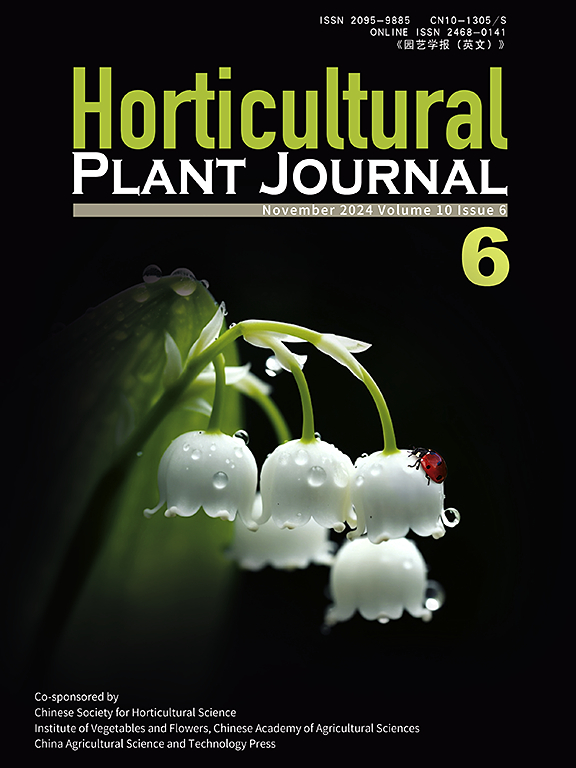基于加权基因共表达网络分析(WGCNA)和全基因组关联研究(GWAS)的太行猿和长尾猿在盐胁迫下的响应模式比较
IF 6.2
1区 农林科学
Q1 HORTICULTURE
引用次数: 0
摘要
悬崖上独特而富有挑战性的环境赋予了蛇爪猴属(太行蛇爪猴和长尾蛇爪猴)对恶劣气候条件的强烈耐受性。在盐胁迫下,生理指标超氧化物歧化酶(SOD)、可溶性蛋白(SP)、叶绿素(Chl)、丙二醛(MDA)、过氧化物酶(POD)和过氧化氢酶(CAT)随着处理水平的升高而普遍升高。通过加权基因共表达网络分析(WGCNA),筛选到太行鱼MEdarkmagenta模块(182个基因)和O. longilobus MEdarkgreen模块(281个基因),它们与SOD、CAT、SP和POD均显著相关。通过全基因组关联研究(GWAS)发现,丰富的snp与SOD指数显著相关。在WGCNA和GWAS中,太行蛇共有11个共同差异表达基因(c-DEGs),龙尾蛇共有17个共同差异表达基因(c-DEGs)。太行对虾主要通过PSMB2、PSMA4和pld12基因的蛋白酶体和脂质代谢途径对胁迫做出响应。而长叶稻则激活氧化磷酸化途径,进而影响氨基酸生物合成、萜类生物合成和信号转导途径(如GA、JA、MAPK),主要涉及MYC2、GID1、CYP82G1、TYRAAT、MAPKKK17_18等基因。与太行稻相比,长叶稻通过更多途径激活了额外的基因来应对盐胁迫。根据May-Wigner理论,简单的基因调控网络比复杂的更稳定。结果表明,太行水蛭的耐受性和适应性优于长叶水蛭。初步探讨了两种植物在盐胁迫下的潜在响应机制。这将为进一步深入研究蛇尾草的耐受性奠定基础,为太行山其他悬崖植物的研究提供线索,并为菊科植物的杂交育种奠定基础。本文章由计算机程序翻译,如有差异,请以英文原文为准。
Comparative responsive patterns of Opisthopappus taihangensis and Opisthopappus longilobus under salt stress by weighted gene co-expression network analysis (WGCNA) and genome-wide association studies (GWAS)
The unique and challenging environment of the cliffs gives Opisthopapus genus (Opisthopappus taihangensis and Opisthopappus longilobus ) a strong tolerance to harsh climatic conditions. Under salt stress, the physiological indexes, superoxide dismutase (SOD), soluble protein (SP), chlorophyll (Chl), malondialdehyde (MDA), peroxidase (POD), and catalase (CAT), generally increased with the treatment levels. Through weighted gene co-expression network analysis (WGCNA), MEdarkmagenta module in O. taihangensis (182 genes) and MEdarkgreen module in O. longilobus (281 genes) were screened, which significantly related with SOD, CAT, SP, and POD. With genome-wide association studies (GWAS), it found that abundant SNPs was significantly correlated with the SOD index. Among WGCNA and GWAS, there was eleven common differentially expressed genes (c-DEGs) in O. taihangensis and seventeen c-DEGs in O. longilobus , respectively. For O. taihangensis, it responded to the stress primarily through the proteasome and lipid metabolism pathways involved in PSMB2 , PSMA4 , and PLD1_2 genes. In contrast, O. longilobus activated the oxidative phosphorylation pathway and then influenced the amino acid biosynthesis, terpenoid biosynthesis, and signaling transduction pathways (e.g., GA, JA, and MAPK) mainly involved MYC2 , GID1 , CYP82G1 , TYRAAT , and MAPKKK17_18 genes. Compared with O. taihangensis, O. longilobus activated additional genes through more pathways to respond to salt stress. According to May-Wigner theory, the simple gene regulatory network was more stable than the complex. Thus, it suggested that O. taihangensis had superior tolerance and adaptation than O. longilobus. The results initially explored the potential responsive mechanism of two species under salt stress. These would establish the foundation for further investigations of the Opisthopapus tolerances, provide clues for the study of other cliff plants in the Taihang Mountains, and lay lights for the performing of Asteraceae cross-breeding.
求助全文
通过发布文献求助,成功后即可免费获取论文全文。
去求助
来源期刊

Horticultural Plant Journal
Environmental Science-Ecology
CiteScore
9.60
自引率
14.00%
发文量
293
审稿时长
33 weeks
期刊介绍:
Horticultural Plant Journal (HPJ) is an OPEN ACCESS international journal. HPJ publishes research related to all horticultural plants, including fruits, vegetables, ornamental plants, tea plants, and medicinal plants, etc. The journal covers all aspects of horticultural crop sciences, including germplasm resources, genetics and breeding, tillage and cultivation, physiology and biochemistry, ecology, genomics, biotechnology, plant protection, postharvest processing, etc. Article types include Original research papers, Reviews, and Short communications.
 求助内容:
求助内容: 应助结果提醒方式:
应助结果提醒方式:


